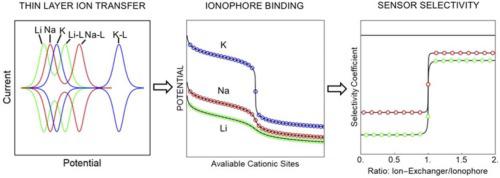Sensors and Actuators B: Chemical ( IF 8.0 ) Pub Date : 2022-01-29 , DOI: 10.1016/j.snb.2022.131428 Canwei Mao 1 , Kye J. Robinson 1 , Dajing Yuan 2 , Eric Bakker 1

|
In ion sensing applications, selective ion-receptor complexation is the molecular basis for endowing the sensing material with selectivity. In this work, thin polymeric membrane-based ion transfer voltammetry is used to investigate ion-receptor complexation, using a range of electrically neutral ionophores and surfactants as examples. Previous studies lacked a convincing approach to eliminate the influence from transducing layer, resulting in deviations of the observed binding constants compared to potentiometric methods. A recently developed method allows for subtracting the potential changes of the transducing layer, thereby overcoming this challenge. Using this approach, a range of ionophores are assessed. Valinomycin for the detection of potassium gave a logarithmic complex formation constant in the membrane of 9.69 ± 0.25 with a 1:1 stoichiometry. Lithium ionophore VI for lithium gave a logarithmic stability constant of 5.97 ± 0.06 with 1:2 complexes; while sodium ionophore X for sodium (7.57 ± 0.03, 1:1) and calcium ionophore IV for calcium (21.57 ± 0.25, 1:3) were also characterized, in addition to their complexes with potential interfering ions. The complex formation of three surfactants with potassium are also explored in membranes containing valinomycin, with Brij-35 (4.88 ± 0.08, 1:1), Triton X-100 (5.63 ± 0.10, 1:1), F-127 (4.63 ± 0.49, 1:1). Limitations of the approach are discussed, which includes the need for electrochemical reversibility and a sufficiently high lipophilicity to adequately retain the components in the membrane
中文翻译:

通过薄层伏安法研究聚合物膜中的离子-离子载体相互作用
在离子传感应用中,选择性离子受体络合是赋予传感材料选择性的分子基础。在这项工作中,基于薄聚合物膜的离子转移伏安法用于研究离子受体络合,使用一系列电中性离子载体和表面活性剂作为示例。以前的研究缺乏一种令人信服的方法来消除转导层的影响,导致观察到的结合常数与电位法相比存在偏差。最近开发的一种方法允许减去转换层的潜在变化,从而克服了这一挑战。使用这种方法,可以评估一系列离子载体。用于检测钾的缬氨霉素在膜中给出的对数复合物形成常数为 9.69 ± 0.25,其中 1:1 化学计量。锂离子载体 VI 与 1:2 配合物的对数稳定性常数为 5.97 ± 0.06;而钠离子载体 X (7.57 ± 0.03, 1:1)和钙离子载体 IV (21.57 ± 0.25, 1:3)也被表征,除了它们与潜在干扰离子的复合物。三种表面活性剂与钾的复合物形成也在含有缬氨霉素的膜中进行了探索,Brij-35 (4.88 ± 0.08, 1:1), Triton X-100 (5.63 ± 0.10, 1:1), F-127 (4.63 ± 0.49, 1:1)。讨论了该方法的局限性,包括需要电化学可逆性和足够高的亲脂性以充分保留膜中的成分 而钠离子载体 X (7.57 ± 0.03, 1:1)和钙离子载体 IV (21.57 ± 0.25, 1:3)也被表征,除了它们与潜在干扰离子的复合物。三种表面活性剂与钾的复合物形成也在含有缬氨霉素的膜中进行了探索,Brij-35 (4.88 ± 0.08, 1:1), Triton X-100 (5.63 ± 0.10, 1:1), F-127 (4.63 ± 0.49, 1:1)。讨论了该方法的局限性,包括需要电化学可逆性和足够高的亲脂性以充分保留膜中的成分 而钠离子载体 X (7.57 ± 0.03, 1:1)和钙离子载体 IV (21.57 ± 0.25, 1:3)也被表征,除了它们与潜在干扰离子的复合物。三种表面活性剂与钾的复合物形成也在含有缬氨霉素的膜中进行了探索,Brij-35 (4.88 ± 0.08, 1:1), Triton X-100 (5.63 ± 0.10, 1:1), F-127 (4.63 ± 0.49, 1:1)。讨论了该方法的局限性,包括需要电化学可逆性和足够高的亲脂性以充分保留膜中的成分 三种表面活性剂与钾的复合物形成也在含有缬氨霉素的膜中进行了探索,Brij-35 (4.88 ± 0.08, 1:1), Triton X-100 (5.63 ± 0.10, 1:1), F-127 (4.63 ± 0.49, 1:1)。讨论了该方法的局限性,包括需要电化学可逆性和足够高的亲脂性以充分保留膜中的成分 三种表面活性剂与钾的复合物形成也在含有缬氨霉素的膜中进行了探索,Brij-35 (4.88 ± 0.08, 1:1), Triton X-100 (5.63 ± 0.10, 1:1), F-127 (4.63 ± 0.49, 1:1)。讨论了该方法的局限性,包括需要电化学可逆性和足够高的亲脂性以充分保留膜中的成分












































 京公网安备 11010802027423号
京公网安备 11010802027423号